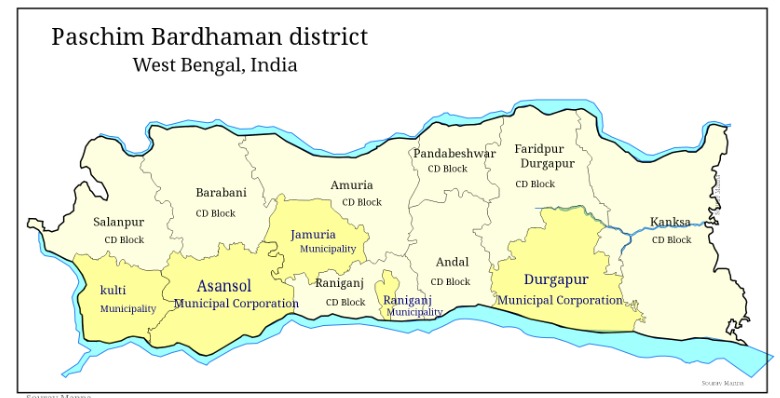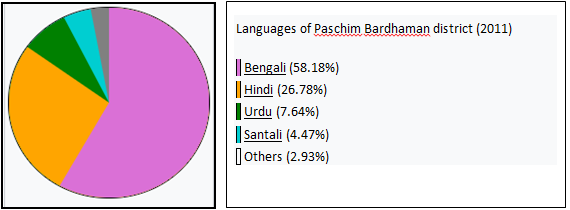Bardhaman district was bifurcated into two districts, Purb Bardhaman
and Paschim Bardhaman, on 7 April 2017.
The rocky undulating topography with laterite soil found in Paschim Bardhaman district
is a sort of extension of the Chota Nagpur plateau. For ages the area was heavily forested and
infested with plunderers and marauders. The discovery of coal in the 18th century led to
industrialisation. Most of the forests in the coal-bearing areas have been cleared but some
areas in the eastern part of the district remained thickly forested till more recent times
and some are still there. The eastern part of the district gradually slopes down to the rice
plains of the agriculturally rich Purba Bardhaman district.

Administrative divisions
The district comprises two subdivisions: Asansol Sadar subdivision and Durgapur subdivision. In Paschim Bardhaman district, there are 8 CD block under two subdivision.
In Asansol Sadar subdivision, there are 4 CD block - Salanpur, Barabani, Jamuria and Raniganj.
In Durgapur subdivision, there are 4 CD block - Andal, Pandabeswar, Faridpur-Durgapur and Kanksa.
Asansol is the district headquarters. There are 16 police stations, 8 development blocks, 2 municipal corporations, 62 Gram panchayats in this district.
Other than municipality areas, each subdivision contains community development blocks which, in turn, are divided into rural areas and census towns. In total there are 66 urban units: 2 municipal corporations, 3 municipalities (which have subsequently been absorbed in Asansol Municipal Corporation) and 65 census towns.
There are two urban agglomerations (UA).
- Asansol, Kulti, Bhanowara, Jamuria, Jemari, Raniganj, Amkula, Murgathaul, Raghunathchak and
Ballavpur together form the Asansol UA.
- Durgapur UA consists of Durgapur, Arrah, Bamunara, Amlajora, Kanksa, Panagarh, Mankar,
Shibpur, Andal, Ukhra, Kajora, Pandabeswar, Ichhapur and Madhaiganj.
Asansol Sadar subdivision
Asansol Sadar subdivision has 10 police stations, 4 community development blocks, 4 panchayat samitis, 35 gram panchayats, 181 mouzas, 165 inhabited villages, 1 municipal corporation, 3 municipalities and 26 census towns+1 (partly). The single municipal corporation is at Asansol. The municipalities are at: Raniganj, Jamuria and Kulti. The census towns are: Chittaranjan, Hindustan CablesTown, Domohani, Bhanowara, Majiara, Pangachhiya, Charanpur, Kunustara, Topsi, Nimsa, Chinchuria, Kenda, Parasia, Ratibati, Chapui, Jemari (J.K. Nagar Township ) , Banshra, Belebathan, Chelad, Murgathaul, Amkula, Baktarnagar, Egara, Sahebganj, Raghunathchak, Ballavpur and Kendra Khottamdi (partly). The subdivision has its headquarters at Asansol.
According to the Kolkata Gazette notification of 3 June 2015, the municipal areas of Kulti, Raniganj and Jamuria were included within the jurisdiction of Asansol Municipal Corporation.
Durgapur subdivision
Durgapur subdivision has 6 police stations, 4 community development blocks, 4 panchayat samitis, 27 gram panchayats, 171 mouzas, 151 inhabited villages, 1 municipal corporation and 39 census towns+1 (partly). The single municipal corporation is at Durgapur. The census towns are: Siduli, Khandra, Chak Bankola, Ukhra, Mahira, Dakshin Khanda, Parashkol, Kajora, Harishpur, Palashban, Dignala, Andal (gram ) , Ondal, Baska, Bilpahari, Ramnagar, Dalurband, Baidyanathpur, Mahal, Konardihi, Nabgram, Sankarpur, Haripur, Chhora, Bahula, Mandarbani, Banagram, Sirsha, Nabaghanapur, Sarpi, Ichhapur, Arra, Gopalpur, Bamunara, Amlajora, Kanksa, Debipur, Prayagpur and Kendra Khottamdi (part). The subdivision has its headquarters at Durgapur.
Urban-rural divide
| District |
Subdivision |
Headquarters |
Area km2 |
Population (2011) |
Rural Population % (2011) |
Urban Population % (2011) |
| Paschim Bardhaman |
Asansol Sadar |
Asansol |
831.89 |
1,672,659 |
16.67 |
83.33 |
| Durgapur |
Durgapur |
771.28 |
1,209,372 |
20.78 |
79.22 |
| Total |
Asansol |
1,603.17 |
2,882,031 |
18.39 |
81.61 |
Demographic
As per the 2011 Census of India data, Paschim Bardhaman district (after bifurcation of Bardhaman district in 2016), had a total population of 2,882,031. There were 1,497,479 (52%) males and 1,384,452 (48%) females. Population below 6 years was 322,268. 2,351,954 (81.61%) lived in urban areas.
As per the 2011 census data the total number of literates in Paschim Bardhaman district, after bifurcation of Bardhaman district in 2017, was 2,015,056 (78.75% of the population over 6 years) out of which males numbered 1,136,990 (85.44% of the male population over 6 years) and females numbered 806,010 (65.55% of the female population over 6 years). Scheduled Castes and Scheduled Tribes made up 628,568 (21.81%) and 161,946 (5.62%) of the population respectively.
| Religion |
Population (2011) |
Percentage (2011) |
| Hinduism |
24,42,414 |
84.75% |
| Tribal religion |
12,572 |
0.44% |
| Islam |
3,84,027 |
13.32% |
| Christianity |
12,636 |
0.44% |
| Others |
30,382 |
1.05% |
| Total Population |
28,82,031 |
100% |
In the 2011 census Hindus were the majority with 2,442,414 (84.75%) in Paschim Bardhaman district. Muslims numbered 384,027 (13.32%), Sikhs were 14,754 (0.51%), almost entirely in urban areas such as Asansol and Durgapur. Christians numbered 12,636 (0.44%) of the population. Other religions (including indigenous religions such as Sarna) numbered 42,954 (1.49%) of the population.

According to the 2011 census, 58.18% of the population in what is now Paschim Bardhaman district spoke Bengali, 26.78% Hindi, 7.64% Urdu and 4.47% Santali as their first language.